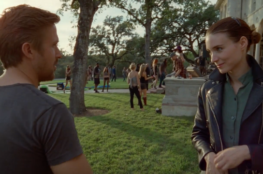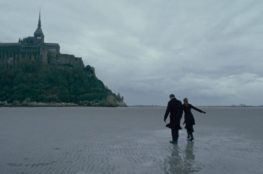The following post is a spoiler-heavy “review” of Rogue One: A Star Wars Story (R1). More accurately, it is a series of thoughts on the film written from the perspective of someone who has been a die-hard fan of the franchise since his youngest years. I am not by any stretch of the imagination a “film buff,” nor do I suffer under any illusion that R1, or any installment in the Star Wars saga (which, since Disney took custody of the property, now includes closely monitored cartoons, books, and comics, in addition to the movies), will ever be deemed “high art.” Moreover, the eight films contain errors, contradictions, continuity flaws, flat characters, under-developed plot points, etc. that can never be fully rectified, especially at this stage in the game. And that’s fine. As you will see from my thoughts below, R1 is intended to both deepen and widen Star Wars, not just in terms of galactic scale, but the motives and desires of both the Empire and the Rebel Alliance. In my opinion, it was highly successful at doing so.
R1 is not a conventional Star Wars film any more than it is a conventional war film (which many reviewers have called it). It is rather a fairly brief, and shockingly intense, glimpse at the ambitions, sacrifices, and compromises that go into the galactic war between the Empire and the loose confederation of rogues and heroes that is the Rebel Alliance. Maybe “rogue” is too light of a word to use considering that one of the central characters to R1, Rebel spy Cassian Andor, is introduced killing one of his informants in order to evade capture on a seedy trading outpost. This won’t be the last time Andor’s penchant for being morally casual comes into play. Even when he walks back his overt lie to fellow protagonist Jyn Erso regarding the pending assassination of her father Galen Erso (more on him in a moment), he still insists on cloaking his dark choices in the garb of righteousness because, unlike Jyn, Andor “stands for something.” But what? Peace for the galaxy? The old Republic? Or just plain old revenge? Andor speaks of his personal losses in vague terms, but it seems they are the only thing driving him to deceive, maim, and murder in the name of the Rebellion.
Jyn Erso, whose characterization is not as clear or sympathetic as Rey from The Force Awakens (TFA), does bring some much needed humanity to R1 through both the tragedy of losing her parents to the Empire (mother murdered, father kidnapped) and her quest to first save, then avenge, Galen. As for Galen, he is R1’s Robert Oppenheimer, only one who would see the “destroyer of worlds” he helped create be no more. Although underexplored, Galen’s motives for working on the Death Star project seem noble enough on the surface: The Empire was going to build the weapon with or without him, so he made himself appear indispensable to the project in order to insert a critical design flaw that the Rebels, or rather Luke Skywalker, would exploit in A New Hope (ANH). However, what is never really discusses is how much Galen’s work on the Death Star (codenamed “Stardust,” Galen’s affectionate name for his daughter Jyn) accelerated the project. Had he refused to contribute, could the program have been delayed by years, maybe even decades? Why didn’t he get the word out in advance that he was working on the battle station so that it could be targeted before it became operational? Despite the aura of nobility and integrity surrounding him, is it possible that Galen really did become immersed in his work on the Death Star and only at the end, when realizing what he had wrought, did he risk his life and the life of an Imperial defector, Bodhi Rook, to inform the Rebels about how to take the weapon out?
On the Imperial side of things, R1 introduces us to Director Orson Krennic, an ambitious son of the Empire who suffers from something of an inferiority complex brought on by no-confidence votes from fellow Imperial honchos Gran Moff Tarkin and Darth Vader. Without getting into what will likely be an endless social-media debate over the filmmaker’s choice to “resurrect” Peter Cushing’s likeness via cutting-edge CGI, the Tarkin of R1 is the same Tarkin from ANH: cold, ruthless, and confident. Krennic may not be Tarkin’s pawn, but he’s much more of a lapdog, looking for scraps from the big boy’s table rather than ever being given a seat. This is reinforced later when Krennic has a customarily uncomfortable encounter with Vader, whose screen time is disappointingly limited. Vader’s skepticism toward the Death Star project is apparent, as is his annoyance that he has to play the cleaner to the trouble Krennic and his new device have caused. It’s easy for Tarkin and Krennic to bask in the afterglow of the Death Star’s laser destroying the ancient city of Jedha; it’s rather harder to cover up the death of millions to the Imperial Senate.
The Senate, for what it’s worth, never comes into direct play in R1 and the only real knowledge we have of its Imperial iteration is from ANH, such as when Tarkin informs Vader and his fellow officers that the Emperor has abolished the bureaucracy in favor of using fear to keep the galaxy’s innumerable star systems in line. However, Vader is surprisingly sensitive to keeping the Senate placated, not only with regards to the destruction of Jedha but also in his apprehension of Princess Leia. Vader, having lived through the waning days of the Republic as Anakin Skywalker, no doubt knew the power of political unrest. Moreover, as the Empire’s chief warrior, it has fallen to him to put down the Rebellion. The last thing he needs is for more systems to join and cause chaos in the galaxy. Vader, in his own twisted way, is a champion of order; he’s just too maligned by grief and raw hatred to see how savage violence will never yield the peaceful galaxy he dreamed of back during his Jedi days.
As for the R1 crew, Andor and Jyn are eventually joined by Rook, along with Force-sensitive Chirrut Îmwe and his best friend, the well-equipped weapons specialist Baze Malbus. Also at their side is R1’s scene-stealing droid, K-2SO. Originally an Imperial enforcer, he has been reprogrammed into Andor’s sardonic and unfiltered right-hand-man (err droid), and fills several roles in the film previously handled by the likes of C-3PO, R2D2, and Chewbacca. By the time R1 reaches its intense and violent third act, K-2SO has become the most sympathetic figure among the R1 crew, displaying a degree of loyalty and self-sacrifice that almost seemed impossible when he first appears as a disgruntled droid more interested in being confirmed in his own pessimism than seeing any of the various missions through.
The final battle in R1 takes place on and above the tropical world of Scarif, home to the Imperial archives. Despite the Rebel Alliance seemingly falling apart over its indecision and fear concerning the Death Star, Jyn and Andor are accompanied by a small band of loyal soldiers on a suicide mission to recover the deadly space station’s plans. It is at this point that R1 begins to feel a lot less like a SW movie and more like Band of Brothers or Blackhawk Down—and that’s a good thing. Because as with all battles, split-second decisions have to be made that can either turn the tide or result in a senseless loss of life. Though the Rebel Alliance eventually gets its act together long enough to support the mission on Scarif, by then it is nearly too late. The ground forces, which were overwhelmed from the beginning, begin to collapse and the central R1 crew, starting with K-2SO, begins paying the price for their commitment to the hope of seeing the Death Star obliterated. The space battle, which may be the franchise’s best since Return of the Jedi (ROTJ), also swings the other way as the Death Star arrives out of hyperspace and Vader’s Star Destroyer—the same one we see at the beginning of ANH—arrives to pick off any Rebel ships that didn’t have time to jump into hyperspace.
Once Jyn and Andor seize and transmit the Death Star plans to a compromised Rebel cruiser, Tarkin chooses to forego the lives of his own men and orders the Death Star to wipe out the Imperial complex on Scarif. Krennic himself has a look of awe more than fear as he sees the weapon he helped build light up the sky before sending a fireball rolling across the horizon to consume the base, along with the Imperials and Rebels still fighting. Jyn and Andor share a final embrace as they stand on Scarif’s beach, no doubt hopeful that their deaths will not be in vain. Meanwhile, in easily the most terrifying, claustrophobic, and panicked scene in Star Wars history, Vader boards the damaged Rebel ship carrying the Death Star plans and begins cutting through terrified Rebel soldiers in a hallway illumined by the hellish red of his lightsaber. Vader, the iconic villain whose “cool factor” is never in doubt, is revealed as a frenzied, merciless monster driven by anger more than any sense of mission. In this one scene at least, the anonymous Rebel soldiers are characterized not by being blaster fodder for equally anonymous Imperial Stormtroopers, but as desperate, frightened men who can only scream, “Help us!” while pounding on a locked blast door in the futile hope of being rescued from a sure and violent death.
In the end, the plans are slipped out of the corpse-filled hallway and onto the Rebel blockade runner carrying Princess Leia (another CGI-based recreation) and . . . hope. Hope, not certainty, is at the heart of R1. And even though Star Wars fans everywhere know what happens next, one of the driving forces of R1 is that none of its characters do. They are uncertain, mistrustful, and even at times cowardly. As Kevin Smith so amusingly demonstrated in his debut film Clerks, the battle between good and evil, light and darkness, freedom and order, etc. in the Star Wars universe is not without collateral damage. Whatever the Rebellion is trying to achieve on behalf of the galaxy, it won’t come without costs, some far less defensible than others.
There are, of course, other matters that could be discussed concerning R1, including the unsubtle use of Middle-Eastern imagery and motifs on Jedha to convey both that land’s holiness and the factions seeking to control it. There are the limited, but noticeable, spiritual elements of R1, too, particularly Îmwe’s dedication to the Force as his sole guiding light. While some Star Wars fans will no doubt criticize the absence of certain unifying elements, such as the opening title crawl and especially John Williams’s score, these are minor matters in the grand scheme of things. R1’s planet-hopping adventure offers a sense of scale to the galaxy that not even the prequels achieved with their elaborate and cartoonish home worlds for even more cartoonish alien races. At the same time R1’s plot and politics eschew the schoolgirl morality that was a hallmark feature of the original trilogy. Although R1 does not knock ANH or Empire Strikes Back from the top of the franchise mountain, it is a more serious film than last year’s highly entertaining TFA and arguably more coherent than ROTJ.



December 16, 2016
>Had he refused to contribute, could the program have been delayed by years, maybe even decades?
A conversation between Tarkin and the Director suggested that the project had been plagued by delays, which might be an indication that, yes, in addition to inserting the design flaw, he might have also dragged his feet.